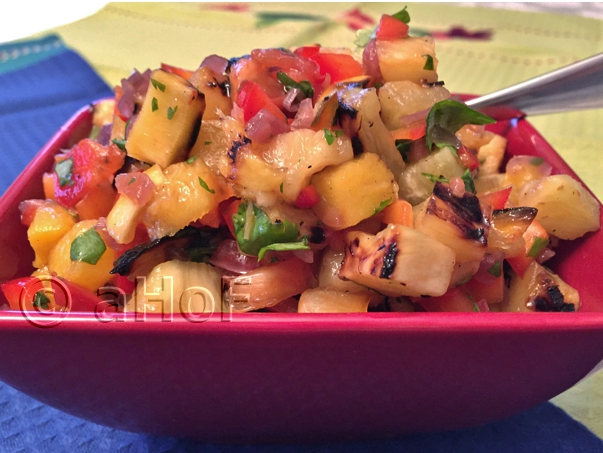 |
| Grilled Pineapple Mango Salsa |
My first thought was some sort of fruity salsa; maybe something with mango, green pepper, some chilies and lime juice. The more thought I put to this, the more I recalled seeing pineapple grilled and with the char marks from the grill, and my mind went in that direction. In the end, I grilled both some sliced pineapple and some mango slices and both went just perfectly together with the other salsa additions.
Keep in mind that to grill mango, the fruit must be just a little firm. Too soft and it is difficult to keep the fruit together just to eat, and far less so if placed on the grill. For this salsa, try and select a mango that is still quite firm; not too green and not too ripe. While I wanted this salsa to accompany the grilled Jerk Chicken, it would also be quite at home at a party with some tortilla chips alongside. In the end, this is what I concocted as my salsa.
Grilled Pineapple Mango Salsa
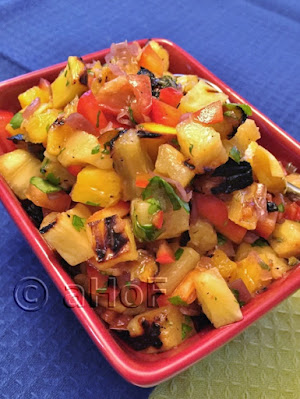 |
| Grilled Pineapple Mango Salsa |
1 good-sized mango, slightly under-ripe
½ fresh pineapple, peeled, sliced
1/2 cup pickled or fresh red onion, chopped
1 red bell pepper, chopped (about ¾ cup)
1 hot pepper of choice, minced
1 small tomato, seeded, chopped (about ½ cup)
½ cup fresh cilantro, chopped
juice of 1 lime (about 1½ to 2 tablespoons)
1 jalapeno, minced (more, if desired)
½ teaspoon salt, or to taste
Heat a grill to high and quickly grill the mango slices and pineapple slices until they acquire nice char lines on either side. The goal is to sear them, but not necessarily cook through.
Once grilled, cut the pineapple and mango into small cubes and place them in a mixing bowl with the remaining ingredients. Toss all ingredients well and taste for seasoning.
Now that I had a salsa I was pleased with, I gave thought to another side dish, and of course rice seemed the most appropriate. To give another nod to the Caribbean flavors I was looking for, I used more of the pineapple I had grilled and added this to the rice as it cooked, along with other similar ingredients to the fruit salsa.
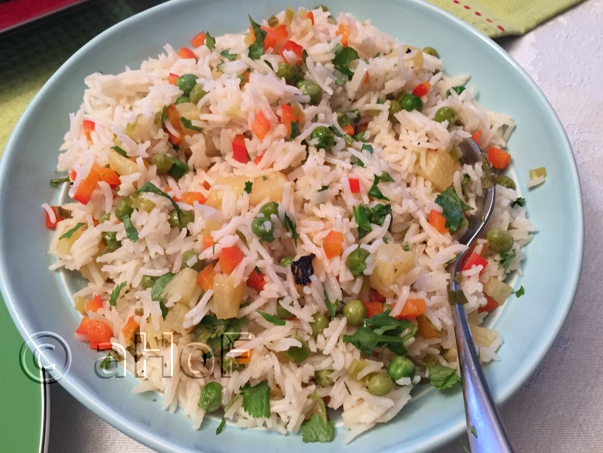 |
| Caribbean Rice |
I have never, ever had difficulty with making rice, though I hear and read often that others have lots of difficulties with making it. I don't have any idea why I have never had problems making rice, but this is the recipe I created, and it came out beautifully light and fluffy and full of flavor.
Caribbean Rice
Serves 4 to 61 cup white rice (I used Basmati)
1 cup fresh pineapple, grilled
¾ cup chopped red bell pepper
½ cup scallions, chopped
1 teaspoon salt
1 tablespoon cooking oil or coconut oil
2 cups water
1 cup frozen peas
¼ cup fresh cilantro, minced
In a medium saucepan, combine the rice, pineapple (cut into small cubes), red bell pepper, scallions, salt, cooking oil and the water. Bring to a boil, reduce heat to low and cover tightly. Time for 15 minutes, at which point the rice should be cooked and fluffy. Add in the frozen peas, give the whole mixture a quick toss with a fork, then cover and turn the burner off, allowing the peas to heat through while keeping their bright green color. Before serving, add in the cilantro and stir. Serve immediately.
About Plantains
To round out the fruity flavors of this meal, I also opted to fry a plantain and serve alongside. To those who might know nothing of plantains and be afraid to use them, here is a little guidance:Plantains are related to bananas, but are far more starchy and need to be cooked to be edible. They may be eaten while still quite green, in which case they have no particular sweetness and can be used as a vegetable. Partially ripe plantains will be yellow, but they are still quire firm. There is more sweetness developed in the fruit at this point and these plantains may be cooked and used as a slightly sweeter side dish, as with sweet potatoes, or they may be sliced and fried. As they cool from cooking, these partially ripe plantains will become rather unpalatably firm, so eat them while warm. Very ripe plantains will have turned nearly completely black. At this point in ripeness, the plantain is very sweet, cooks quickly and easily, and is wonderful used in more of a dessert category.
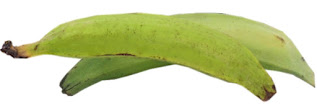 |
| Green Plantains |
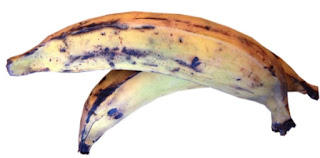 |
| Medium Ripe Plantains |
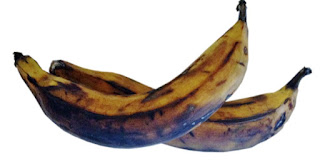 |
| Fully Ripe Plantains |
My passion is teaching people how to create a harmony of flavors with their cooking, and passing along my love and joy of food, both simple or exotic, plain or fancy. I continue my journey in ethnic and domestic cuisines, continuing my journey to explore diverse culinary experiences and hopefully to start you on a journey of your own. Join me also at A Harmony of Flavors on Facebook, and Pinterest.

No comments:
Post a Comment